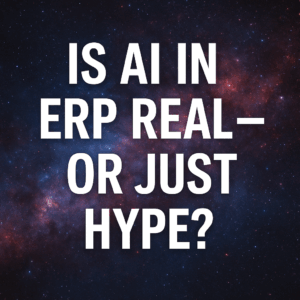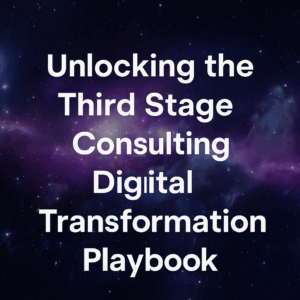Many might not be aware, but the enterprise technology sector is governed by a cartel. What exactly is this cartel, and how can we understand its workings? That is the focus of our discussion today.

In our experience assisting clients with their digital transformations over the years, we have observed a prevalent bias and undue pressure exerted on customers of enterprise technology providers. These substantial enterprise technology entities operate under what can be described as a cartel. This group, closely interconnected, aims to convey meticulously crafted messages that are inherently biased, primarily designed to promote software sales. Today, I intend to discuss the nature of this enterprise technology software cartel, the essential knowledge required, and the strategies necessary to navigate and counteract these challenges.
Table of Contents
ToggleForced Cloud Migrations
The enterprise technology space, particularly within the ERP software industry, exhibits cartel-like behaviors in several ways. One primary indication is how they compel their customers towards cloud adoption. Many legacy software providers, including industry giants such as SAP, Oracle, and Microsoft, originally developed their technologies for on-premise use. Customers have relied on these legacy systems for decades. However, as we advance through the 2020s, these legacy software providers are pressuring their customers to transition from old on-premise systems to the cloud. While migrating to the cloud might be the optimal solution for numerous organizations, the coercive approach, reminiscent of cartels, adopted by these software vendors raises concerns. Enterprises today grapple with this challenge, trying to discern the best path for their migration from on-premise to the cloud.
One crucial piece of advice for these enterprises is to undertake this transition on their own terms. If the present moment aligns with a company’s strategy to transition to the cloud, they should pursue it. Otherwise, they should explore alternatives. Supporting on-premise systems during the interim, before a cloud migration, is a viable option. If the migration process is expected to be lengthier than what the vendors suggest, organizations should allow themselves the necessary time. Going off maintenance or facing lack of support for older systems is a potential risk. However, this risk might be more manageable than hastily moving to the cloud before the organization is adequately prepared. A significant concern within this cartel-like behavior is the aggressive push to transition customers from on-premise setups to cloud environments.

Rigged Ecosystem
Another method by which the software technology industry exerts undue influence over their customers is through a meticulously crafted ecosystem established over decades. While the creation of this ecosystem by major software vendors is undeniably a marketing and sales masterstroke, compelling vast numbers of people to utilize and deploy their software, its impact on customers cannot be overlooked. This ecosystem not only leads to inherent biases but also introduces several blind spots that customers must be cognizant of.
To elucidate what constitutes this “ecosystem,” it encompasses more than just the core software vendors. System integrators, technology implementers, value-added resellers, and even industry analysts form integral parts of this complex web. All these entities are financially incentivized by software vendors to reinforce and disseminate the vendors’ sales and marketing narratives. Such a structure inevitably skews perspectives, leading to biases and blind spots, especially when customers conduct research on specific products.
Being aware of this manipulated ecosystem is vital. It underscores the importance of seeking objective, unbiased advice and information when making decisions in the realm of software technology.
Unrealistic Expectations
Due to their proficiency in sales and marketing, software vendors often set unrealistic expectations for their customers. These vendors excel in presenting the numerous features, potential advantages, and the value that their technologies can offer to an organization. While it is essential to understand the strengths, benefits, and potential value of technology, it is equally crucial to be aware of its drawbacks, associated risks, and the challenges of deploying such software.
Every technology, including ERP software and other enterprise solutions, comes with its set of risks. Failing to recognize these risks can result in challenges during implementation. The biases and unrealistic expectations propagated by the vendors lead organizations to believe that they can deploy ERP software or other enterprise technologies with fewer resources, time, money, and risks than are realistically involved. Such misconceptions can cause significant problems for customers. This tactic of setting unrealistic expectations is yet another manifestation of the cartel-like behavior observed in the enterprise technology sector.
Best Practices
Another tactic employed by software vendors that mirrors cartel behavior is their assertion of possessing “best practices.” Almost all of these vendors claim to offer industry best practices or solutions ideally tailored for individual clients. It’s presumptuous for a software vendor to consider themselves the ultimate authority on best practices, especially when, in truth, universally applicable best practices do not exist.
Enterprise technology companies ardently promote this concept of best practices. If clients express dissatisfaction, reluctance, or resistance to these so-called best practices, vendors often retort that the clients are simply averse to change. They argue that if only the clients would adopt their best practices, all would proceed smoothly. However, the truth remains that there aren’t universally best practices; there are only practices that best suit a particular organization’s needs.
To navigate this, organizations must conduct a thorough assessment of their priorities, essential requirements, deal-breakers, and other critical criteria. When evaluating these software solutions, they will invariably identify discrepancies in the vendor’s proclaimed best practices. It then becomes the responsibility of the organization to determine how to bridge these gaps and mitigate associated risks. It’s crucial to be wary of the “best practices” rhetoric, as while they might not exist in the form vendors present them, these vendors will still ardently push their perspective to their customer base.
Co-Innovation
As numerous prominent software providers progress in their product development and transition to cloud-based solutions, a recurring theme has emerged: the promotion of “co-innovation” to their customer base. Co-innovation, in essence, is often used by these vendors to obscure the absence of capabilities a specific customer might require.
For instance, we are currently collaborating with several companies engaged with major enterprise technology providers. These providers, traditionally offering on-premise solutions, have now transitioned to cloud-based offerings. These cloud solutions frequently exhibit significant gaps in their features. To address these gaps, these software vendors suggest a co-innovation approach, promising to collaboratively develop the required functionality. They present this as a mutual benefit: the customer receives the desired functionality, while the vendor obtains a product enhancement they can market to other similar businesses.
However, clients must be cautious. While it might seem that the vendors are attempting to foster collaboration or partnership, the underlying reality is that they are asking customers to fund their research and development, effectively having them pay to rectify the software’s deficiencies. While some organizations might find this arrangement acceptable, it’s imperative to understand the inherent risks. Entering a co-innovation arrangement is particularly perilous. We have observed numerous failures stemming from this concept. The primary issue is that it often involves customizing or entirely creating software functionalities that the original product was never designed to support. For organizations with a high risk tolerance, this might be feasible. However, it’s vital to recognize the potential pitfalls of co-innovation — a reality that many software vendors often won’t disclose.
Ongoing Support
Another tactic that characterizes the software industry’s cartel-like behavior is their attempt to dominate ongoing support for their products. They aim to establish a monopoly, ensuring that no other entity can offer similar support for their software. For instance, SAP and Oracle not only provide continuous support for their products but have also announced plans to discontinue support for certain legacy products in the future.
It’s concerning that these companies might terminate support for long-standing customers who have invested significant resources into deploying their software, especially when done without adequate justification. Furthermore, when third-party startups emerge, offering support for products from companies like SAP or Oracle, these major players often try to stifle such competition. Their goal is to be the sole providers of such support, allowing them to set prices, dictate terms, or potentially push clients towards their cloud solutions.
This monopolistic approach to ongoing support exemplifies how software vendors, wielding considerable market power, can often operate at the detriment of their customers.
Hot To Get Out Of The Cartel
The pressing concern is how to navigate the software industry, often likened to a cartel. It’s not about evading the deployment of enterprise technology; it’s about approaching it with an informed perspective and understanding the intricacies of this so-called “software cartel.” The most effective way to mitigate the influence of this cartel is by diversifying your options.
Considering third-party providers for support is one avenue. Engaging third-party advisors for project and program management during the implementation phase is another strategy. Seeking guidance from unbiased, technology-agnostic consultants when deciding on which technology to deploy and at what time within your organization can also be invaluable. These third-party entities can offer an independent digital strategy and roadmap tailored to your organization’s needs.
It’s essential to not solely rely on the software vendors and the ecosystem that accompanies them, including system integrators, industry analysts, and other consultants. This ecosystem tends to promote a uniform solution, which may not necessarily align with your organization’s unique requirements.
Third Stage Consulting, the firm I represent, is one such company that offers these services. However, regardless of your chosen consulting partner, always ensure you’re exploring various options. Avoid putting all your trust in a single entity or vendor. This perspective aims to guide organizations in managing the challenges posed by the dominant players in today’s technology sector.
I would enjoy brainstorming ideas with you if you are looking to strategize an upcoming transformation or are looking at selecting an ERP system, so please feel free to contact me at eric.kimberling@thirdstage-consulting.com. I am happy to be a sounding board as you continue your digital transformation journey.





